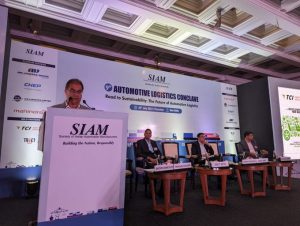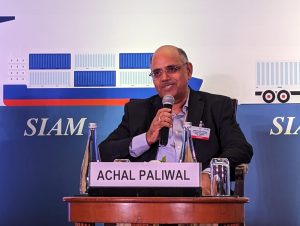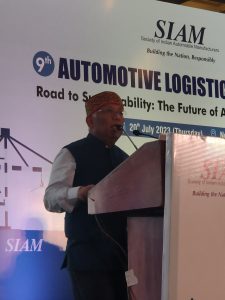The Society of Indian Automobile Manufacturers (SIAM) on 20th July organised the 9th SIAM Automotive Logistics Conclave to address the challenges of the industry. The conclave, themed ‘Road to Sustainability: The Future of Automotive Logistics’ had active participation from several speakers including senior government officials, logistics heads of automobile companies, and experts from the automobile supply chain.
The first session was centred around “Automotive Logistics: Practices for Enhancing Efficiencies”. During the session, Ashish Choudhary, Operating Head, of Honda Motorcycle & Scooters India Pvt. Ltd, said, “Implementing disruptive technologies is crucial for improving efficiency in the automotive business. Time, distance, and efficiency are key factors affecting cost and delivery. Emphasizing the use of relevant technology, like Google Maps, will facilitate our efforts to achieve the highest level of efficiency and ensure on-time delivery.”
He also highlighted that roadways in India keep evolving constantly; hence it is important to ensure that the distance of transporting the vehicles is being covered by carriers efficiently and in-time delivery is being carried out for a satisfactory customer experience.
 Jasjit Sethi, CEO, of TCI Supply Chain Solutions, said, “We must focus on improving how we implement the technology such as GPS tracking system. Expanding the rail network and coastal shipping will enhance the supply chain. Moreover, there is a need for robust collaborations between the automotive industry and logistics solutions providers to improve efficiency.”
Jasjit Sethi, CEO, of TCI Supply Chain Solutions, said, “We must focus on improving how we implement the technology such as GPS tracking system. Expanding the rail network and coastal shipping will enhance the supply chain. Moreover, there is a need for robust collaborations between the automotive industry and logistics solutions providers to improve efficiency.”
While talking about the things that can be done for enabling seamless goods transportation in inter and intrastate routes, Anil Chhikara, Dy. Commissioner, Transport Department, Government of NCT of Delhi, said, “To enhance ease in transportation and establish India as a driver powerhouse, we must focus on improving drivers’ abilities, educating them about rules and regulations, and addressing their issues, primarily developing requisite infrastructure on highways like sanitation facilities. Compliance with government regulations and adopting cutting-edge technology in vehicles will strengthen automotive logistics in India and ensure seamless transportation”. He also highlighted that working in silos would not work. The industry and government must work together.
S P Singh, Joint Secretary (IAHE & Logistic), Ministry of Road Transport and Highways in the same line said, “We are moving from the siloed approach to a collective approach. With the advent of PM Gati Shakti, we are creating a platform to carry out integrated planning and embed technology in all operations, thus enhancing logistics efficiencies in the Automotive Sector.”
 Achal Paliwal, General Manager, Tata Motors Ltd., said, “Treating drivers with care and providing requisite facilities is essential for the automotive industry’s success. India’s improved road connectivity and ongoing highway development will enhance seamless movement. Equipping vehicles with eating and sleeping facilities is crucial for drivers’ comfort and welfare. OEMs and Logistics Service Providers need to collaborate with the government and take requisite actions to enhance logistics efficiency.”
Achal Paliwal, General Manager, Tata Motors Ltd., said, “Treating drivers with care and providing requisite facilities is essential for the automotive industry’s success. India’s improved road connectivity and ongoing highway development will enhance seamless movement. Equipping vehicles with eating and sleeping facilities is crucial for drivers’ comfort and welfare. OEMs and Logistics Service Providers need to collaborate with the government and take requisite actions to enhance logistics efficiency.”
Other Factors like better infrastructure facilities, technological advancements and improved Ease of Living need to be looked at for ensuring the welfare of the drivers and simultaneously address their shortage for Automotive logistics. The OEMs and LSPs must work collaboratively with the government to take action and enable required shifts, said Paliwal.
During a panel discussion on “Synergies between Rail & Road Logistics”, S. P. Singh, Joint Secretary (IAHE & Logistic), Ministry of Road Transport and Highways, said, “The government is focusing on the 4Is—Infrastructure, Information, IT, and Integration—to improve the effectiveness of the Indian supply chain. Under PM Gati Shakti, government ministries and departments create plans after examining the requirements of India’s logistics infrastructure. It is pushing digitization and aiming to create a suitable information system to assist the industry in determining the shortest distance, by emphasizing integration.”
Prakash Gaur, CEO, of National Highway Logistics Management Limited, said, “A multi-stakeholder approach is required for the automobile industry to expand and successfully meet consumer demand. The government is continuously working to lower logistics costs, which is crucial for enhancing the customer experience and fostering the sector’s expansion. The private sector must come up with plans to create a strong logistics ecosystem.”
 Amit Kumar Ghosh, Additional Secretary (LA & Highways), Ministry of Road Transport and Highways talked from the side of truck drives by stating, “We must think of an alert system for drivers ensuring that they aren’t overly tired and not dozing off on road.” As transportation cost reduction is a major thing the industry is working Ghosh said, the ministry is working on seamless toll systems.
Amit Kumar Ghosh, Additional Secretary (LA & Highways), Ministry of Road Transport and Highways talked from the side of truck drives by stating, “We must think of an alert system for drivers ensuring that they aren’t overly tired and not dozing off on road.” As transportation cost reduction is a major thing the industry is working Ghosh said, the ministry is working on seamless toll systems.
Drivers are an important pillar towards ensuring seamless transportation of vehicles. It is imperative to provide them with safety and dignity. We have also initiated working on air-conditioned cabins, especially for those driving on long highways where the average speed is high. This will help in improving the overall efficiency of the truckers.
The event concluded with Automobile Industry’s recommendations for improving logistics efficiencies was shared by Rakesh Sen, Chairman, of SIAM Logistics Group & Vice President, of Mahindra & Mahindra Ltd and Tapan Ghosh, Co-Chairman, of SIAM Logistics Group & Vice President, Sales, Hyundai Motor India.
During the concluding session, Vinod Aggarwal, President, SIAM and CEO & MD, of Volvo Eicher Commercial Vehicles Ltd., said, “The Indian automobile industry needs to increase efficiency and long-term sustainability. The National Logistics Policy (NLP), it must focus on lowering logistics costs of transportation, warehousing, and administration, which account for about 14 per cent of GDP. Additionally, the issues faced in increasing efficiency, such as time-consuming tasks like loading and unloading of cargo, must be highlighted. Additionally, the industry must concentrate on addressing the driver shortage by enhancing the appeal of this profession, by improving amenities like insurance and working conditions.”
E Srinivas, Joint Secretary (Logistics), Department for Promotion of Industry and Internal Trade (DPIIT), Ministry of Commerce & Industry, said, “The automobile sector’s contribution is 6 per cent in the GDP and significant in the FDI. India has climbed six places in the World Logistic Performance Index (LPI) and occupied 38th position. This has become possible due to the government’s constant efforts and futuristic initiatives. The PM Gatishakti and National Logistic Policy (NLP) aim to create a robust logistics ecosystem in the country while reducing costs.”
He then highlighted that it is very important to set long-term sustainable goals to reduce the cost of transporting vehicles and improve the overall efficiency of the sector. He also said that as government understand how important it is to upskill the employees and one platform working in the iGot.



















